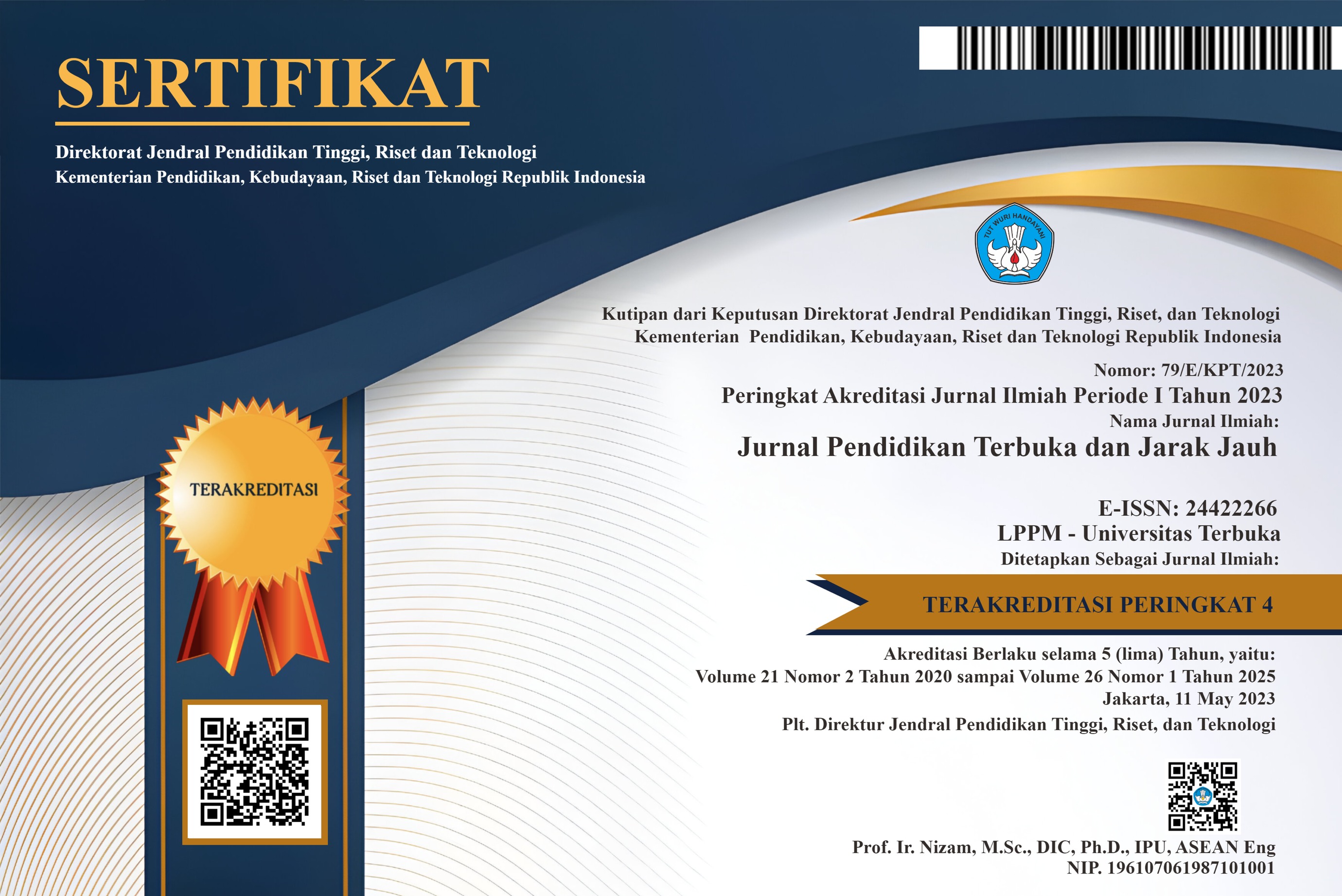Exploring Learning Analytics In E-Learning: A Comprehensive Analysis of Student Characteristics and Behavior
DOI:
https://doi.org/10.33830/ptjj.v24i2.5055.2023Keywords:
Learning analytics, Exploratory Data Analysis, E-learning, Learning Management SystemAbstract
This article aims to explore learning analytics in e-learning through a comprehensive analysis of student characteristics and behavior. E-learning has become increasingly significant in education, particularly due to the social situation influenced by the pandemic. The Learning Management System (LMS) has become a crucial tool for educators to track and record student learning in e-learning environments. Learning analytics can aid in understanding the context of students, ensuring that they receive a personalized learning experience aligned with learning objectives. However, educators often face challenges in conducting learning analytics for e-learning students, primarily due to the large number of students to analyze and limited data availability. This study seeks to provide a detailed description of e-learning students within the Open and Distance Education (ODE) system. ODE students exhibit high diversity in demographic profiles, learning behaviors, and competency backgrounds. To support this research, we utilize datasets containing student demographic profiles and learning activity data during e-learning sessions. The datasets are obtained from the academic system and LMS log data of Universitas Terbuka. The article employs Exploratory Data Analysis (EDA) and data science approaches as the foundation for predictive and prescriptive analytics of student learning outcomes. Relevant features are extracted from the dataset to build a robust predictive model. The analysis results present patterns and relationships between student characteristics, learning behaviors, and academic achievements. This research aims to provide valuable insights for the development of more effective and personalized e-learning strategies to enhance student learning outcomes in the context of distance education. Moreover, the analysis findings can serve as a basis for informed academic decision-making to improve the quality of e-learning environments.
References
Balachandran, A. (2014). Large scale data analytics of user behavior for improving content delivery (Doctoral thesis, Carnegie Mellon University, 2014). Carnegie Mellon University.
Berry, L. J. (2017). Using learning analytics to predict academic success in online and face-to-face learning environments (Dissertation, Doctor of Education in Educational Technology, Boise State University, 2017) [Boise State University]. In Boise State University (Issue May). https://doi.org/10.1038/132817a0
Bolliger, D. U., Inan, F. A., & Wasilik, O. (2014). Development and Validation of the Online Instructor Satisfaction Measure (OISM). Educational Technology & Society, 17(2), 183–195. https://doi.org/10.1080/01587910902845949; Bourne, J., Moore, J.C., (2005) Elements of quality online education: Engaging communities., http://sloanconsortium.org/publications/books/vol6_summary.pdf, Needham, MA: Sloan Consortium. Retrieved from (Eds.); Bower, B.L., Distance education: Facing the faculty challenge (2001) Online Journal of Distance Learning Administration, 4 (2). , http://wwwwestga.edu/~distance/ojdla/summer42/bower42.html, Retrieved from; Burden, K., Atkinson, S., Evaluating pedagogical affo
Bravo-Agapito, J., Romero, S. J., & Pamplona, S. (2021). Early prediction of undergraduate Student’s academic performance in completely online learning: A five-year study. Computers in Human Behavior, 115(02), 106595. https://doi.org/10.1016/j.chb.2020.106595
Chatti, M. A., Dyckhoff, A. L., Schroeder, U., & Thüs, H. (2012). A reference model for learning analytics. International Journal of Technology Enhanced Learning. https://doi.org/10.1504/IJTEL.2012.051815
Dick, W., Carey, L., & Carey, J. O. (2015). The systematic design of instruction (J. Johnston (ed.); Eighth). Pearson Education, Inc., www.ablongman.com.
Dietric, D., Heller, B., & Yang, B. (2015). Data science and big data analytics: Discovering, analyzing, visualizing, and presenting data (C. Long (ed.); 1st ed.). John Wiley & Sons, Inc. www.wiley.com
Figueira, Á. (2017). Mining Moodle Logs for Grade Prediction. TEEM 2017, October 18–20, 2017, Cádiz, Spain, 1–8. https://doi.org/10.1145/3144826.3145394
Hussain, S., Çİfçİ, M. A., Tamayo, J. D., & Safdar, A. (2018). Big Data and Learning Analytics Model. International Journal of Computer Sciences and Engineering, 6(7), 654–3. https://doi.org/https://doi.org/10.26438/ijcse/v6i7.654663
Leedy, P. D., & Ormrod, J. E. (2015). Practical research: planning and design (J. W. Johnston (ed.); Eleventh). Pearson Education Limited.
Moodle Statistics. (2023). Moodle Statistics. Retrieved from https://stats.moodle.org/
Morris, L. V., Finnegan, C., & Wu, S. S. (2005). Tracking student behavior, persistence, and achievement in online courses. Internet and Higher Education, 8(3), 221–231. https://doi.org/10.1016/j.iheduc.2005.06.009
Mubarak, A., Cao, H., & Zhanga, W. (2022). Prediction of students’ early dropout based on their interaction logs in online learning environment. Interactive Learning Environments, 30(8), 1414–1433. https://doi.org/10.1080/10494820.2020.1727529
Purwoningsih, T., Santoso, H. B., & Hasibuan, Z. A. (2020). Data analytics of students’ profiles and activities in a full online learning context. 5th International Conference on Informatics and Computing, ICIC 2020, 1–8. https://doi.org/10.1109/ICIC50835.2020.9288540
Purwoningsih, T., Santoso, H. B., Puspitasari, K. A., & Hasibuan, Z. A. (2021). Early prediction of students’ academic achievement: categorical data from fully online learning on machine-learning classification algorithms. Journal of Hunan University Natural Sciences, 48(9), 131–141. https://doi.org/http://jonuns.com/index.php/journal/article/view/713/710
Ren, Z. (2019). Academic Performance Prediction with Machine Learning Techniques.
Siemens, G., & Long, P. (2011). Penetrating the Fog: Analytics in Learning and Education. EDUCAUSE Review, 46(5), 30. http://er.educause.edu/articles/2011/9/penetrating-the-fog-analytics-in-learning-and-education
Yang, J., Rahardja, S., & Fränti, P. (2019). Outlier detection: How to threshold outlier scores? ACM International Conference Proceeding Series, AIIPCC2019, December 2019, Sanya, China, 1–6. https://doi.org/10.1145/3371425.3371427
Downloads
Published
How to Cite
Issue
Section
License
Copyright (c) 2023 Tuti Purwoningsih, Wahyu Inayanto, Muhammad Yunus

This work is licensed under a Creative Commons Attribution-ShareAlike 4.0 International License.





